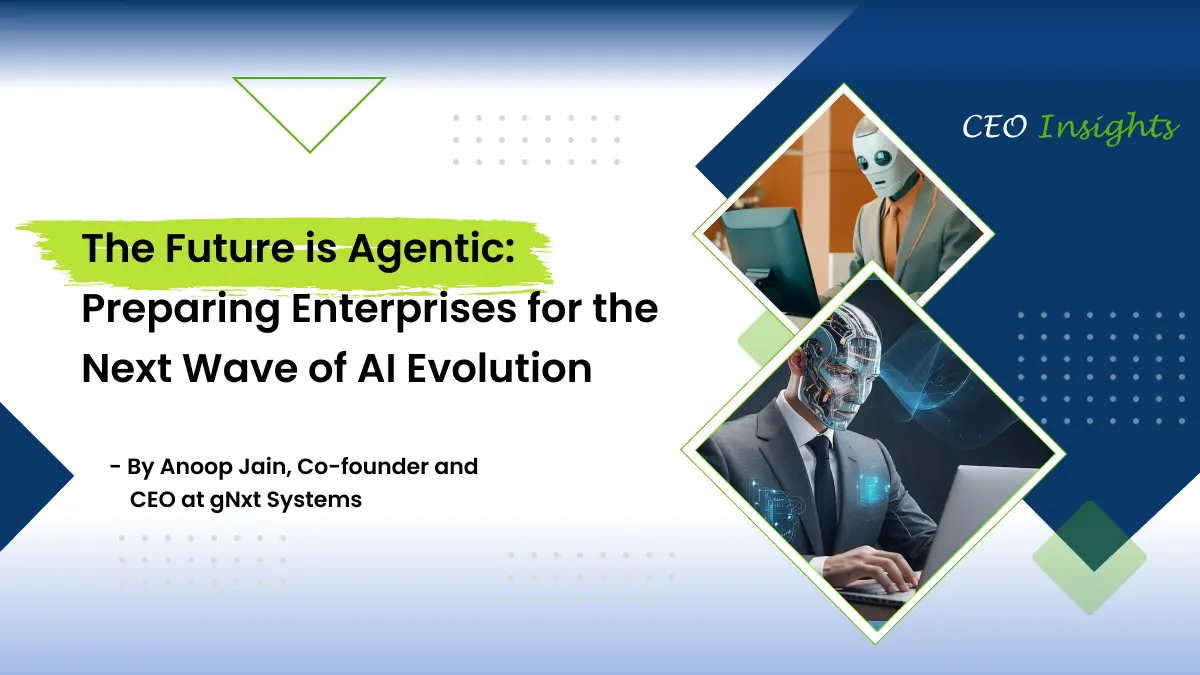- June 6, 2025
- by Anoop Jain
The Future is Agentic: Preparing Enterprises for the Next Wave of AI Evolution
In the era of intelligent transformation, enterprises are experiencing a seismic shift in how work gets done. Artificial Intelligence (AI) has already transformed industries—from predictive analytics in finance to automation in manufacturing. However, the next frontier of AI innovation is not just about faster processing or better predictions. It’s about autonomous intelligence—systems that think, learn, and act independently. Welcome to the age of Agentic AI.
Agentic AI marks a bold evolution in enterprise AI strategy. It pushes beyond traditional automation to introduce autonomous agents capable of understanding intent, making contextual decisions, and executing complex workflows across systems. As we step into this new era, the enterprises that embrace agentic systems will lead; those that lag will struggle to remain competitive.
What is Agentic AI?

Agentic AI refers to systems designed to act as autonomous agents—software entities capable of setting goals, planning actions, and learning from their environment to optimize outcomes. Unlike conventional AI models, which depend heavily on human commands and predefined logic, agentic systems can initiate actions, interact with other systems, and evolve based on real-time feedback.
Think of an agentic AI as a digital teammate—not just a tool. These agents are capable of complex decision-making across functions like finance, operations, HR, and customer service. They can navigate ERP systems, fetch data from multiple sources, assess business context, and make strategic decisions with minimal human intervention. In essence, agentic AI blurs the lines between human capabilities and machine intelligence.
This evolution is driven by advances in neuro-symbolic AI, multi-agent reinforcement learning, LLMs (large language models), and orchestration platforms that allow digital agents to operate seamlessly in live enterprise environments.
The Shift from Automation to Autonomy
We are moving from automation to autonomy, from workflows to workflows that think.”
— Satya Nadella, Chairman & CEO, Microsoft
In the past decade, businesses have implemented AI to automate tasks—invoice processing, customer queries, data extraction, etc. While these automations improved efficiency, they remained rule-based and reactive, requiring supervision and often failing in unpredictable situations.
Agentic AI changes that. It introduces autonomy into digital systems, enabling them to handle ambiguity, interact with other agents, and optimize their own performance. These agents don’t just complete a task—they understand the business goal, determine the optimal path, and learn from the outcomes.
For instance, in a supply chain, instead of just notifying a delay, an agentic system would analyze the impact, suggest alternative suppliers, negotiate terms via API, and update the ERP automatically—without human prompting.
Why Enterprises Must Pay Attention
1. Complex Decision-Making at Scale
Modern enterprises operate in highly volatile environments, where decision-making must be agile, real-time, and data-driven. Traditional systems struggle to keep up with these demands. Agentic AI introduces cognitive intelligence that allows systems to evaluate trade-offs, prioritize actions, and simulate outcomes across various business scenarios.
From dynamic pricing in retail to fraud detection in fintech, the ability to make intelligent decisions at scale is becoming a core competitive advantage.
2. Human-AI Collaboration
Rather than replacing jobs, agentic systems are designed to augment human abilities. These agents serve as digital coworkers—handling low-level decisions, gathering insights, and enabling professionals to focus on creative, strategic, and relationship-driven work.
In software development, for example, agentic copilots can generate code, test variations, and propose architecture recommendations, significantly reducing time-to-market. In HR, they can evaluate thousands of resumes, shortlist candidates, and schedule interviews based on hiring manager preferences.
3. Business Continuity and Resilience
In a world increasingly threatened by cyberattacks, supply chain disruptions, and compliance risks, enterprises need systems that can respond proactively and intelligently. Agentic AI can continuously monitor KPIs, detect anomalies, and take corrective action—such as rerouting logistics, alerting stakeholders, or even mitigating IT threats—ensuring operational resilience without delay.
gNxt Systems: Leading the Agentic AI Movement

At the forefront of this transformative wave is gNxt Systems, a next-gen enterprise automation company reimagining how businesses work with intelligent technology. gNxt’s Agentic AI platform enables businesses to deploy autonomous digital agents tailored to their unique workflows and industry challenges.
What Makes gNxt Agentic AI Different
- Process-Aware Agents
gNxt’s agents are trained not just on data, but on entire business processes, enabling them to understand enterprise logic, dependencies, and goals. This makes them fundamentally different from general-purpose chatbots or RPA tools. - Cross-System Intelligence
These agents are designed to interact with diverse systems—ERPs, CRMs, HRMS, SCMs—making them capable of managing multi-system workflows like procurement, order management, or financial reconciliation end-to-end. - Secure, Scalable Architecture
With enterprise-grade security, data privacy compliance, and modular deployment, gNxt’s platform is built for organizations looking to scale AI adoption without compromising control.
“Agentic AI marks a profound shift. At gNxt, we are not building AI to replace jobs, but to transform work—elevating the human workforce with digital agents that think, learn, and adapt.”
— ANOOP JAIN, Co-founder, gNxt Systems
Industry Perspectives on Agentic AI
🔹 Deloitte
“Agentic AI will become the backbone of autonomous enterprises. It’s not about replacing employees but enabling them to do more with less friction, more intelligence, and greater speed.”
🔹 Accenture
“Companies leveraging agentic intelligence see up to 40% improvement in process throughput, 30% faster decision-making, and up to 25% reduction in operational costs.”
🔹 OpenAI
“Agentic models enable software systems to break down complex goals into sub-tasks, reason across steps, and achieve outcomes independently—this is the new era of human-AI collaboration.”
Real-World Use Cases of Agentic AI
🏭 Manufacturing
Agentic AI agents dynamically adjust production plans based on raw material availability, customer demand, and equipment health—minimizing downtime and optimizing output.
🛍 Retail
From real-time inventory adjustments to customer engagement personalization, agentic systems handle logistics, pricing, and promotions across regions with zero human latency.
💳 Finance
Agents handle compliance monitoring, detect anomalies in real-time, and assist customers with intelligent financial advisory—leading to smarter risk management and enhanced customer satisfaction.
🚚 Supply Chain
Agents anticipate disruptions, reroute deliveries, negotiate with vendors, and ensure customer SLAs are met—all while adapting to changing conditions like weather, strikes, or geopolitical events.
Preparing for an Agentic Future: What Enterprises Must Do
✅ Rethink IT Strategy
CIOs must move beyond infrastructure thinking to focus on intelligence orchestration. Building an AI-ready foundation involves data harmonization, inter-system APIs, and LLM integration strategies.
✅ Empower Cross-Functional AI Adoption
Agentic AI is not an IT initiative alone. Involve process owners from operations, finance, marketing, and HR to build AI agents that solve real business problems.
✅ Partner with Proven Platforms
Platforms like gNxt Systems offer turnkey agentic solutions that integrate with your existing digital ecosystem—enabling faster adoption with measurable ROI.
Conclusion: The Agentic Era is Here
The transition from reactive AI to agentic intelligence is not just a technological upgrade—it’s a paradigm shift in how businesses operate. Enterprises that prepare today will not only optimize performance but unlock new levels of innovation, agility, and competitiveness.
Agentic AI is the bridge between automation and autonomy, between data and decision, between systems and outcomes.
The future is agentic. Is your enterprise ready?
Want to see Agentic AI in action? Explore gNxt Systems’ Agentic AI solutions and discover how digital agents can elevate your enterprise.
Read this blog. It might interest you :
What Is Model Context Protocol (MCP) and Why It Matters for AI Developers in 2025
About Author

CEO at gNxt Systems
with 25+ years of expertise, Mr. Anoop Jain delivers complex projects, driving innovation through IT strategies and inspiring teams to achieve milestones in a competitive, technology-driven landscape.


